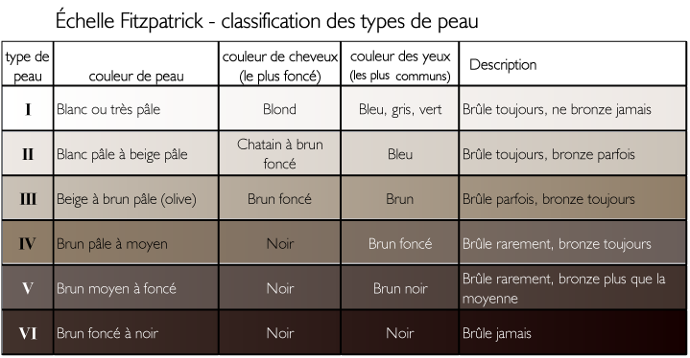It only takes five minutes of peak sun exposure for bare skin to burn, so choosing sunscreen with the right SPF (sun protection factor) is key. Note that five minutes is the average since sun tolerance depends on the skin’s phototype.
Skin phototypes
Phototype is determined by the skin’s tolerance to the sun. The chart below outlines 6 phototype levels, with level 6 representing very dark skin colour with a high tolerance for the sun (with a few exceptions).

As you can see, the skin’s sensitivity to the sun doesn’t necessarily depend on hair colour but on skin type. People with blond hair tend to have more delicate skin but that’s not always the case, and even people with dark hair can have skin that’s sensitive to the sun.
SPF (sun protection factor) levels, explained.
Sunscreen with SPF 10 allows you to stay in the sun 10 times longer than you could without sun protection during the sun’s peak hours, which is now classified as 11 am to 3 pm (it used to be 12 pm to 2 pm). There is likely a strong correlation between the increase in the sun’s peak hours and the increase in greenhouse gases that are depleting the ozone layer.
To calculate how long your sun protection will last, you need to take your skin’s phototype into account as well as the time it takes for your skin to start burning when it’s exposed to the sun when it’s at its most intense.
Skin that takes 10 minutes to burn without sun protection will be protected for 10 times longer than skin without SPF 10—so a total of 100 minutes before it will show signs of burning. With SPF 30, you’ll be protected for 30 times longer, which translates to 300 minutes of protection before you need to reapply.
However, it’s important to keep in mind that these are just estimates and there are several factors that can weaken or even eliminate any sun protection you apply. These include:
What percentage of UV rays are blocked by SPF 20, 30 and 50?
Protections that have a higher FPS are therefore not without risks. The article Les crèmes solaires, minérales ou chimiques? allows you to see more clearly.
